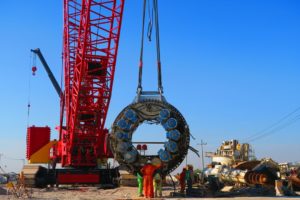Heavy-Duty machines: Square The Circle Of Lifetime And UX
2020/08/17
This article is proposed by WITEKIO
Witekio has been working with heavy-duty vehicle and machine manufacturers for years.
Whether lifting machines or trucks, bulldozers, or shovels, in the mines or in the fields, it’s a sector flush with challenges and a strong demand for strategic software innovation.

There are four key challenges that the heavy-duty industry faces today :
1. Growing user experience expectations to align with user “B2C” standard
Like all other sectors of the economy, manufacturers of heavy-duty vehicles and machines meet increasing demands for usability, an improved user experience, a user-friendly software interface, while still embedding sophisticated features and workflows.
2. Implement connectivity while offering the highest level of security
Connectivity enables new features and new services: remote monitoring, transform data into insights, connected scenarios with other appliances, as a service model, etc. However, the consequence of any hacking could be dramatic for human life, assets, and reputation. How to innovate without compromising at all security standards?
3. Optimize R&D costs on a versatile product line by building a re-usable core platform
The vehicle industry was in the forerunner of platforming on mechanical, engine, and production lines. How to apply the same approach to increasingly complex software?
4. Offer support over a very long product lifetime
Unlike B2C appliances, Heavy-duty vehicles and machines are built to last, and this means loading them with rugged, robust, and resilient software that will power this extended lifetime use and enable proper maintenance.
Software is key to meeting the challenges of the heavy-duty industry
While product hardware has long attracted the attention of customers, it’s software that is helping manufacturers to meet the challenges of the market.
Whether addressing UX and UI concerns, enabling and maintaining network connectivity, empowering maintenance over the air (OTA), or providing clear points of differentiation on a crowded and competitive market, software is key to meet the challenges of the heavy duty industry.

4 ways Witekio delivers value for heavy-duty machines manufacturers
1. A customer-centric focus dedicated to UX
Heavy-duty vehicles and machines are complex products and are deployed in some of the most complex working environments on Earth. This complex working environment in turn engenders complex business models and, oftentimes, leads to the development of complex graphical interfaces for end users.
Witekio experts understand the complexities of the heavy-duty vehicle and machine industry and the first reflex towards providing complicated user experiences to ensure end-users have access to everything they need all at once.
But Witekio also understands the importance of the user experience in generating value for manufacturers both in the short term (customer satisfaction with the product) and in the long term (customer loyalty and recurring revenue). This customer-centric focus allows Witekio to improve user interfaces to provide modern, appropriate, and innovative solutions.
Their experience means they know what is most important to the end-user: intuitive, fluid, and touch interfaces, maximum efficiency of movement and user input, remote piloting and supervision, smart phone and tablet integrations, and always-on network connectivity.
This focus on the customer and the capacity to adapt the UX to the demands of the end user creates value for the manufacturer, lifts customer satisfaction ratings, and contributes to the development of a brand that is reliable, robust, resilient, and a first-choice option for industry professionals.
2. Connectivity
Heavy-duty vehicles and machines can benefit from internet connectivity much as other industries do. Remote monitoring, remote control, interconnections with other connected machines or the cloud, and new service functionality can all flow from adding connectivity to a vehicle or machine.
Yet at the same time a connected vehicle or machine is vulnerable to hacking. With bad actors keen to exploit any vulnerability, security is paramount for connected devices and this is why Witekio’s ‘security by design’ approach is so effective for the industry.
Witekio can implement real-time connectivity and control via a CAN interface (for example, with i.MX 8M Plus, 8QuadMax, 8x, or RT1xxx) or via an industrial ethernet connection (TSN with i.MX 8M Plus or 8XLIte). This offers CAN driver support at the gateway level including, for example, a joystick could communicate with controllers of the machine or vehicle motor.
Their long experience connecting and integrating these systems has taught us how to overcome some of the vehicle-specific protocols that challenge others. The CAN bus, Wi-Fi and ethernet driver support, offline and online management modes, and the integration of cellular technologies to enable software updates, communication, and connectivity are all areas where Witekio can and do add significant value to heavy-duty vehicle and machine manufacturers.
3. Software platform expertise and know-how
Software robustness is essential for vehicles and machines that are expected to have long lifetimes and endure significant stresses. A common software platform across multiple vehicles and machines helps to ensure a robust and familiar user interface for users while also accelerating time to market for the manufacturer and cutting innovation costs.
Witekio is experienced in developing software platforms for manufacturers. These platforms offer a core of code that is common to an entire range of products which means bringing a new product to market no longer demands a new code base. What’s more, not only is the code base shared but improvements to the platform code base over time mean that quality improvements are pushed to all products automatically. Adding a new product to a software platform can be as simple as adapting to the specific demands of that product, for example the size of a screen in a tractor cab or the connectivity demands of a bulldozer).
Witekio engineers ensure the robustness and resilience of the platform code base with an industrialized product development and deployment process in its software factory. Witekio’s software factory makes sure that appropriate and optimized development cycles (code reviews, testing, deployment strategies, and continuous integration) are employed from day one.
Finally, Witekio’s expertise in remote software updates OTA to heavy-duty vehicles and machines comes standard. Heavy-duty vehicles are expensive to access and mean incurring significant costs for customers who have to take them offline for software updates. Delivering these updates remotely and in a bandwidth-optimized fashion means savings for the customers and a robust, differentiated, and incremental means for manufacturers to ensure lifetime product quality.
4. Robust code and long-term support
The first step to delivering an optimized, innovative, marketable and supported software solution is getting it right at the lowest level: on-board the vehicle or machine. Witekio has extensive expertise in developing software for heavy-duty hardware and a history of success in bringing an end-user experience dream into reality.
Proprietary embedded protocols that work effectively but that are complex and unsightly for end-users can be customized and adapted. Software engineers routinely customize operating systems and image sizes and optimize boot times, driver performance, and energy consumption. They regularly deploy software on multi-core architectures (for example, real-time for the product core and anti-collision elements, isolation between critical and non-critical components) and are comfortable with all kinds of dual architectures (dual core, MPU+MPU, MCU+MCU, MCU+MPU).
But code doesn’t just need to be written, it needs to be maintained and optimized over time. Witekio has extensive experience maintaining the entire software stack, including the OS and pushing security patches. Where an open source OS like Linux is employed, for example, there are regular and useful updates but – for all the value they add – the update and maintenance processes can be burdensome. Their experts combine their understanding of Yocto and the Linux kernel with their understanding of your BSP so the right updates can be pushed at the right time over the air with FullMetalUpdate tool.
Witekio’s deep understanding of complex heavy-duty systems and their expertise in Linux and other proprietary systems are brought to bear in order to deliver a superior solution perfectly suited to the demands of manufacturers.









